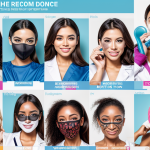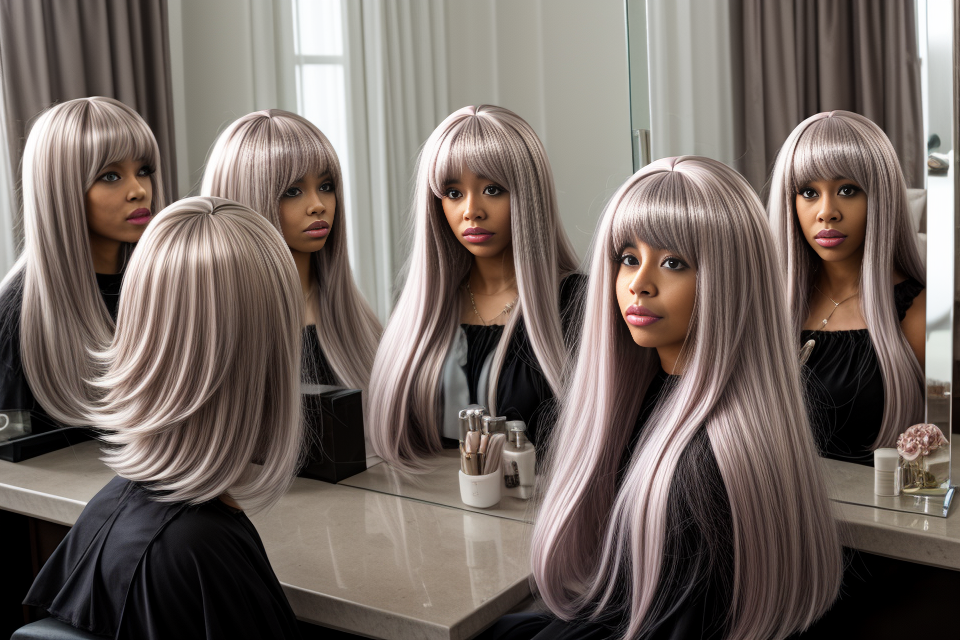Wigs have been a part of human history for centuries, with people wearing them for various reasons. From fashion statements to medical conditions, wigs have been a versatile solution for individuals looking to change their hairstyle or cover up hair loss. But what is the purpose of wearing wigs? In this article, we will explore the different reasons why people wear wigs and the benefits they provide. From enhancing one’s appearance to protecting one’s hair, wigs serve as a practical and stylish solution for many individuals. So, let’s dive in and discover the purpose of wearing wigs.
The purpose of wearing wigs has varied throughout history and across different cultures. In ancient times, wigs were often worn as a symbol of status or as part of religious or cultural rituals. In more recent times, wigs have been worn for practical purposes such as to cover up baldness or as a fashion statement. Additionally, wigs are sometimes worn as part of a costume or for stage performances. Overall, the purpose of wearing wigs can vary widely depending on the individual and the context in which they are worn.
What are Wigs?
Definition and Brief History
Wigs are hairpieces worn on the head for various reasons, including for disguise, fashion, religious reasons, or as a form of therapy for people who have lost their hair due to medical conditions such as alopecia or chemotherapy. Wigs have been worn by people of different genders and ages for centuries, with evidence of wig-wearing dating back to ancient civilizations such as Egypt and Greece.
The use of wigs as a fashion accessory gained popularity in Europe during the 17th and 18th centuries, particularly among the nobility and the wealthy classes. During this time, wigs were often made from real human hair and were styled in a variety of ways, from perukes (large, pompadour-style wigs) to more natural-looking styles.
Over time, the use of wigs evolved and changed, and they are now used for a variety of purposes. While some people still wear wigs as a fashion statement or for religious reasons, others use them as a way to cope with hair loss or as a form of self-expression. Regardless of the reason for wearing a wig, it remains an important part of personal style and identity for many people.
Types of Wigs
Wigs are an essential part of fashion and style for many people. They come in various types, each with its unique characteristics and benefits.
Natural wigs are made from human hair that has been collected from donors. They are usually made from real hair and can be styled and treated like natural hair. Natural wigs are the most popular type of wig, as they are versatile and can be used for a variety of occasions.
Synthetic wigs are made from synthetic fibers, such as polyester or nylon. They are more affordable than natural wigs and can be styled using heat tools such as curling irons and flat irons. Synthetic wigs are also less susceptible to damage from water and sweat.
Human hair wigs are made from real human hair that has been collected from donors. They are usually made from real hair and can be styled and treated like natural hair. Human hair wigs are the most popular type of wig, as they are versatile and can be used for a variety of occasions.
Lace front wigs are a type of wig that has a lace front attached to it. The lace front is a thin, breathable material that covers the forehead and hairline. Lace front wigs are popular because they provide a natural-looking hairline and can be worn without a wig cap.
Why do People Wear Wigs?
For Medical Reasons
Alopecia
Alopecia is an autoimmune disorder that causes hair loss. People with alopecia may wear wigs to conceal their hair loss and to maintain a normal appearance. There are different types of alopecia, including alopecia areata, which causes patchy hair loss, and alopecia totalis, which causes total hair loss on the scalp.
Chemotherapy
Chemotherapy is a treatment for cancer that uses drugs to kill cancer cells. One of the side effects of chemotherapy is hair loss, which can be temporary or permanent. People undergoing chemotherapy may wear wigs to hide their hair loss and to maintain their appearance during treatment.
Scalp Conditions
There are several scalp conditions that can cause hair loss, such as psoriasis, eczema, and seborrheic dermatitis. People with these conditions may wear wigs to cover up their hair loss and to avoid embarrassment or stigma associated with their condition. In addition, wigs can help protect the scalp from further irritation and prevent further hair loss.
For Fashion and Style
- Hair Extension
- One of the primary reasons for wearing wigs is to extend the length and thickness of one’s hair. People may choose to wear wigs to achieve a specific look or to cover up thinning or balding hair.
- Wigs can be made from various materials, such as synthetic fibers or human hair, and can be styled in a variety of ways to create different looks.
- Additionally, wigs can be used to add volume and texture to the hair, which can be especially useful for people with fine or limp hair.
- Changing Hairstyle
- Another reason for wearing wigs is to change one’s hairstyle without having to cut or chemically treat their own hair.
- Wigs can be worn in a variety of styles, from short and sleek to long and flowing, and can be easily removed or replaced as desired.
- This allows people to experiment with different hairstyles without committing to a permanent change or damaging their own hair.
- Disguise
- Wigs can also be used as a form of disguise, either for practical purposes or for entertainment.
- For example, wigs may be worn by actors or musicians to portray a specific character or persona on stage or screen.
- Wigs may also be worn for practical purposes, such as by undercover police officers or by people who wish to maintain their anonymity in public.
Overall, wigs are often worn for fashion and style purposes, allowing people to experiment with different hairstyles and extend the length and thickness of their hair. Wigs can be made from various materials and can be styled in a variety of ways to create different looks, making them a versatile and popular choice for those looking to change their appearance.
For Cultural and Religious Reasons
- Traditional dress codes
In some cultures, wearing wigs is a traditional practice that has been passed down through generations. This may be due to historical or cultural reasons, such as the use of wigs in theater or certain occupations. In these cases, wearing a wig is seen as a way to maintain tradition and pay homage to the past.
- Head coverings for religious purposes
Many religions require their followers to cover their heads as a sign of respect or devotion. For example, in some Christian denominations, women are required to cover their hair during worship services as a sign of modesty and humility. Similarly, in Judaism, men are required to cover their heads as a sign of reverence when praying or studying religious texts. Wearing a wig can be a convenient way for individuals to comply with these religious requirements without having to style their own hair.
Wigs can also be used as a form of disguise. This is often the case in Hollywood, where actors and actresses may wear wigs to transform themselves into different characters for movies and TV shows. Wigs can also be used as a form of disguise in everyday life, such as when someone wants to hide their identity while attending a costume party or engaging in a prank.
- Medical reasons
In some cases, people may wear wigs as a result of medical conditions such as alopecia or chemotherapy. Wearing a wig can be a way for individuals to regain their confidence and feel more comfortable in their own skin. Additionally, wigs can be used as a way to cover up hair loss that may be caused by a medical condition, allowing individuals to maintain a more natural appearance.
Overall, there are many reasons why people may choose to wear wigs. Whether it’s for cultural or religious reasons, as a form of disguise, or as a result of a medical condition, wigs can play an important role in many aspects of life.
How to Choose the Right Wig?
Factors to Consider
When choosing the right wig, there are several factors to consider to ensure that the wig complements your natural features and suits your lifestyle. These factors include:
- Hair Type: The texture and density of your natural hair can affect the type of wig you choose. For example, if you have curly hair, you may want to choose a wig with a similar texture to create a natural look. If you have straight hair, you may want to choose a wig with a bit more volume to add body and dimension to your style.
- Skin Tone: Your skin tone can also play a role in choosing the right wig. If you have a cool undertone, look for wigs with cool tones such as silver or blue. If you have a warm undertone, look for wigs with warm tones such as gold or copper.
- Face Shape: Your face shape can also impact the type of wig you choose. For example, if you have a round face, you may want to choose a wig with angles and sharp features to create contrast. If you have an oval face, you may want to choose a wig with a more rounded shape to complement your natural features.
- Lifestyle: Your lifestyle can also play a role in choosing the right wig. If you lead an active lifestyle, you may want to choose a wig made from synthetic materials that can withstand wear and tear. If you prefer a more natural look, you may want to choose a wig made from human hair that can be styled and treated like your own hair.
Tips for Buying a Wig
Buying a wig can be an exciting experience, but it can also be overwhelming, especially if you’re new to wearing wigs. Here are some tips to help you choose the right wig for your needs:
Measuring your head
Before you start shopping for a wig, it’s important to measure your head. The circumference of your head is usually the most important measurement to take. You can use a measuring tape or a string to measure your head. A typical wig size ranges from 21 to 24 inches, but you should consult the vendor’s size chart for more accurate measurements.
Choosing a reputable vendor
When buying a wig, it’s important to choose a reputable vendor. Look for a vendor that specializes in high-quality wigs and has a good reputation in the industry. You can read reviews and ask for recommendations from friends or family members who have purchased wigs before.
Proper care and maintenance
Proper care and maintenance is crucial to the longevity of your wig. Different wigs require different care methods, so it’s important to read the vendor’s care instructions carefully. Generally, you should avoid using hot tools like curling irons or flat irons on your wig, as this can damage the fibers. You should also avoid washing your wig too often, as this can cause it to lose its shape and color.
Wig Styling and Maintenance
Wig Styling Tips
When it comes to styling wigs, there are a few tips to keep in mind to ensure that you get the most out of your wig and maintain its appearance.
- Washing and conditioning: The first step in styling your wig is to wash and condition it. This will remove any tangles and restore the wig’s natural texture. When washing your wig, use a mild shampoo and warm water. Gently detangle the wig with a wide-tooth comb or your fingers while it is still damp. Once the wig is clean, apply a wig conditioner and comb through it to remove any knots.
- Styling tools: Once your wig is clean and conditioned, you can start styling it. There are a variety of styling tools available, including curling irons, flat irons, and hair dryers. It’s important to use the right tool for the right style, and to use them correctly to avoid damaging the wig. For example, when using a curling iron, make sure to use a heat protectant spray and only curl the wig in small sections to avoid causing too much heat damage.
- Heat damage prevention: Heat damage is one of the most common problems when styling wigs. To prevent heat damage, it’s important to use heat protectant sprays and to avoid using too much heat when styling. You should also avoid using hot tools on the same spot for too long, as this can cause irreversible damage. If you do notice any heat damage, you can try using a wig repair cream to restore the wig’s texture and appearance.
Wig Maintenance
Proper maintenance is crucial to ensuring that your wig stays in good condition and looks its best. Here are some tips for maintaining your wig:
Brushing and Combing
Brushing and combing your wig regularly can help prevent tangles and keep it looking neat. Use a wig brush or comb specifically designed for synthetic or human hair wigs, and brush gently from the ends of the hair towards the scalp. Avoid using regular hair brushes or combs, as they can cause damage to the fibers of the wig.
Moisturizing
Moisturizing your wig can help keep it looking healthy and prevent it from drying out or becoming brittle. Use a moisturizing spray or cream specifically designed for synthetic or human hair wigs, and apply it evenly to the hair. Avoid using water or other liquids, as they can cause the wig to become too wet and lead to mold or mildew growth.
Sleeping with a Wig
Sleeping with your wig on can help prevent it from becoming tangled or damaged during the night. However, it’s important to use a wig cap or headband to secure the wig to your head and prevent it from shifting around while you sleep. Avoid sleeping on your wig, as this can cause pressure marks and damage to the hair fibers.
Famous People Who Wear Wigs
Celebrities and Public Figures
- Movie and TV characters
- Musicians and singers
- Politicians and public figures
In the world of entertainment, wigs have become a staple for many celebrities and public figures. Whether it’s for a movie or TV character, musicians, or politicians, wigs are used to transform actors and performers into the characters they are portraying. Here are some examples of famous people who wear wigs:
Movie and TV characters
Wigs are often used in the film and television industry to change the appearance of actors and actresses. For example, Meryl Streep famously wore a wig in the movie “The Iron Lady” to portray former British Prime Minister Margaret Thatcher. In the TV show “Game of Thrones,” many characters wear wigs to reflect their social status and culture.
Musicians and singers
Musicians and singers also use wigs to enhance their image and stage presence. For instance, Prince famously wore a purple wig during his performances in the 1980s. Lady Gaga is also known for wearing wigs and different hair styles in her music videos and live performances.
Politicians and public figures
Politicians and public figures also use wigs to enhance their image and project a certain image to the public. For example, former President Barack Obama wore a wig in his high school yearbook photo. In India, many politicians wear wigs as a symbol of respect for the legal system.
Overall, wigs are an essential part of the entertainment industry, and celebrities and public figures use them to enhance their image and portray different characters.
Wig Advocates
Overcoming Insecurities
Wigs can serve as a way for individuals to overcome their insecurities about their hair. For example, some people may feel self-conscious about their hair loss due to medical conditions like alopecia or chemotherapy. Wearing a wig can help them feel more confident and conceal their hair loss, allowing them to present themselves in a more positive light.
Expressing Creativity
Wigs can also be a form of self-expression for those who want to experiment with different styles without committing to a permanent change. Famous people such as Lady Gaga and Katy Perry have been known to wear wigs as part of their stage costumes, showcasing their creativity and artistic flair. Wearing a wig can allow individuals to try out new looks and feel more adventurous with their style.
Empowering Self-Confidence
Wearing a wig can also empower individuals to feel more confident in their appearance. For some people, wearing a wig can help them feel more put together and polished, whether they are attending a special event or simply running errands. Additionally, wigs can provide a sense of camouflage for those who may feel self-conscious about their natural hair texture or color. By wearing a wig, individuals can feel more comfortable in their own skin and present themselves in a more positive light.
FAQs
1. What is the purpose of wearing wigs?
The purpose of wearing wigs is to cover up hair loss or to change one’s hairstyle without damaging their natural hair. Wigs can be worn for various reasons, such as medical reasons, cultural reasons, or personal preference.
2. Are wigs only for women?
No, wigs are not only for women. Men can also wear wigs for various reasons, such as medical reasons, cultural reasons, or personal preference.
3. How long do wigs last?
The lifespan of a wig depends on various factors, such as the quality of the wig, how often it is worn, and how well it is taken care of. On average, a good quality wig can last for several months to a year or more.
4. Can I wear a wig every day?
Yes, you can wear a wig every day if you want to. However, it is important to take proper care of your wig to ensure it lasts as long as possible. This includes storing your wig properly when not in use, using the right products to clean and style your wig, and avoiding excessive heat styling.
5. Can I swim or shower with a wig?
Yes, you can swim and shower with a wig. However, it is important to treat your wig gently when wet, as it may stretch or lose its shape. It is also recommended to use a wig cap or a swim cap to protect your hair underneath the wig.
6. Can I style my wig?
Yes, you can style your wig using heat styling tools, such as curling irons or flat irons, or by using styling products, such as mousse or gel. However, it is important to use these tools and products sparingly and to avoid exposing your wig to excessive heat, as this can damage the fibers and reduce the lifespan of your wig.









